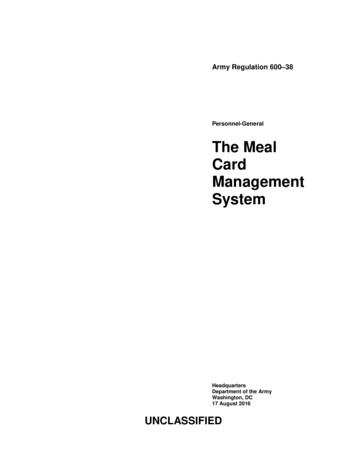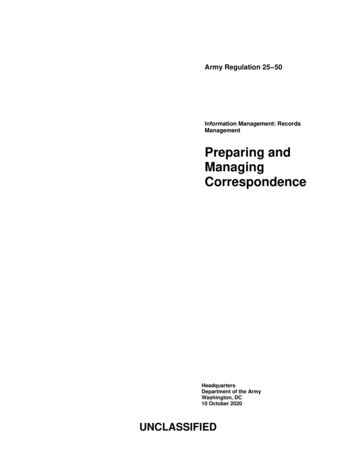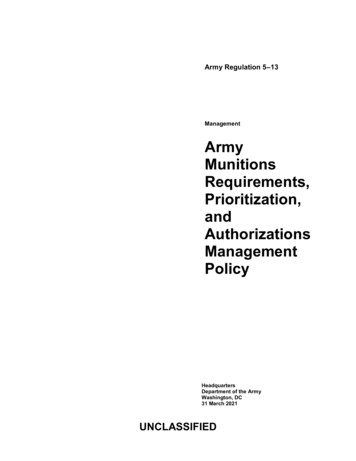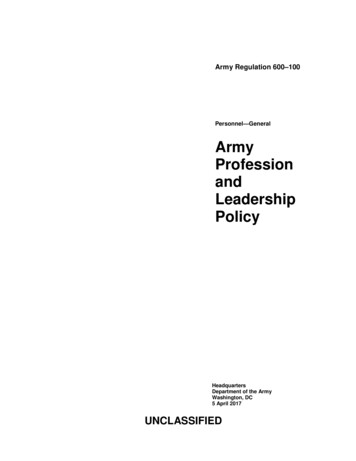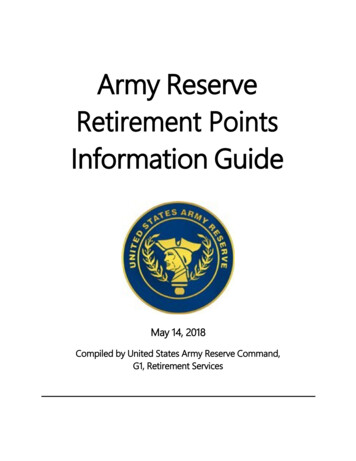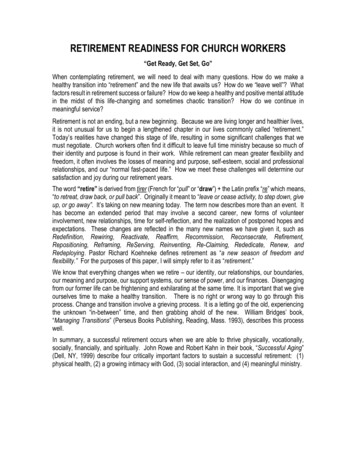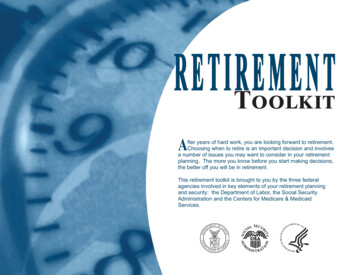
Transcription
U.S. ArmyRetirement Planning Guide2020Retirement is a process, not an event!Seek the advice of those who’ve gone before you
OCTOBER 2019U.S. ARMY RETIREMENT PLANNING GUIDEPREPARED BY:Army Retirement ServicesDeputy Chief of Staff, G-1Arlington, VA 22202-3531Front Cover Caption: Soldiers with 75th Ranger Regiment scale the cliffs like Rangers did during Operation Overlord 75years ago at Omaha Beach, Pointe du Hoc, Normandy, France, June 5, 2019. More than 1,300 U.S. service memberspartnered with 950 troops from across Europe and Canada, converged in northwestern France to commemorate the 75thanniversary of Operation Overlord, the WWII Allied invasion of Normandy, commonly known as D-Day. (U.S. Army photoby Markus Rauchenberger)
FOREWORDAs you prepare to retire, you’ll face a confusing maze of policies, procedures, and benefits decisions. Without a plan and aguide to this maze, you’re likely to miss decision points, rush your decisions, and increase the stress on yourself and yourfamily.My intent is to provide you with a planning guide that will help you navigate your personal off-ramp from the Armysuperhighway. If you have suggestions for improvements to this guide, please send them to me at the addresses below.First, I recommend you embrace the thought that “retirement is a process, not an event.” Your peers, who are now retired,want you to know that you will regret delaying your planning and ignoring the execution of your plan. I urge you to listen to thesubject matter experts, do your homework, ask questions, and involve your family – you aren’t the only one making thistransition.Between this guide, your Retirement Services Officer, the Change of Mission newsletter, the MyArmyBenefits website andHelp Desk, and the Transition Assistance Program website and counselors, you have incredible resources to make yourretirement transition a success – but it will take your own planning and discipline to make it happen on schedule. It’s importantto note that there are two sets of mandatory preparation classes. The Transition Assistance Program AND the RetirementServices Program are complementary and mandatory. I urge you to start both 24 months before you retire – well before youdrop your retirement request. And don’t underestimate the mental transition you’re about to make. Life in retirement will bedifferent, but the grass is green on this side of the fence too. You will miss the sense of purpose, the camaraderie, and theSoldiers you’ve lived with for so long. But make no mistake, the Army will still need you after you retire. Your mission willchange, but your duty to the country will not.After you retire, I want you to be a Soldier for Life – a true advocate for the Army wherever you live. The mission for RetiredSoldiers is to “HIRE and INSPIRE”: Help veterans get jobs. Inspire our youth to follow in your footsteps into military service.Inspire Americans to know, understand, and support their Soldiers and their Army.Thank you for your long and dedicated service to the nation.Mark E. OverbergDirector, Army Retirement ServicesDeputy Chief of Staff, G-1Headquarters, Department of the ArmyArmyRSO@mail.milArmy Retirement Services251 18th Street South, Suite 210Arlington, VA 22202-3531NOTE: CLICKING ON ANY PAGE NUMBER IN THIS GUIDE WILL RETURN YOU TO THE TABLE OF CONTENTSii
TABLE OF CONTENTSForeword .iiChapter 1 — Introduction1-11-2Soldier for Life Mindset . 1Retirement is a Process . 1Chapter 2 — How to Plan Your Retirement2-1 General . 32-2 The Spouse’s Perspective . 52-3 When You Can Retire . 52-4 Change of Mission 62-5 Soldier for Life: Transition Assistance Program. 62-62-72-82-9Retirement Physical. 7Household Goods Transportation . 7Retirement Recognition . 8Transition Leave & Permissive TDY . 9Chapter 3 — Retirement Benefits3-13-23-33-4Defense Enrollment Eligibility Reporting System (DEERS). 10Military Identification and Privilege Cards. 10MyArmyBenefits (MAB) . 11Army Emergency Relief. 12Chapter 4 — Retirement Pay4-14-24-34-44-54-6Retired Pay Plans . 13Disability Retirement 16Combat-Related Special Compensation (CRSC) . 16Concurrent Retirement and Disability Pay (CRDP) 17Other Retired Pay Information 17Thrift Savings Plan (TSP) .18Chapter 5 — Medical Care5-1 TRICARE Programs–Medical Care after Retirement . 195-2 TRICARE Select . 205-3 TRICARE Prime 215-4 TRICARE Plus . 215-5 Uniformed Services Family Health Plan . 225-6 TRICARE Retired Reserve (TRR) . 225-7 TRICARE Young Adults (TYA).225-8 TRICARE for Life (TFL) . 225-9 Temporary Disabled Retired List (TDRL) Beneficiaries . 235-10 TRICARE Pharmacy Benefits .23
5-11 Federal Employees Dental and Vision Insurance Program (FEDVIP) . 23Chapter 6 — Department of Veterans Affairs (VA) Benefits6-1 General . 256-2 VA Disability Compensation . 256-36-46-56-66-76-8Benefits Delivery at Discharge and Fully Developed Claim Programs 26VA Home Loans 26GI Bill . 26Converting SGLI to VGLI 27VA Medical Care . 27VA Dental Care . 27Chapter 7 — Survivor Benefits7-17-27-37-47-5General . 28Survivor Benefit Plan 28Basic SBP Questions Answered 29SBP’s Perceived Negatives 33The Reserve Component Survivor Benefit Plan (RCSBP) 357-6 RCSBP Eligibility . . 357-7 RCSBP Election Options . . 357-8 RCSBP Election Categories 357-9 RCSBP Election Costs .36Chapter 8 — Uniformed Services Former Spouses’ Protection Act8-18-28-38-48-5General . 37Background . 37Division of Retired Pay 37Survivor Benefit Plan (SBP) . 38Military Identification and Privilege Cards 40Chapter 9 — Reserve Component Retirement System9-1 General . 419-2 Nonregular Retired Pay Process 419-3 Changes to Retirement Age for Certain Reserve Component Soldiers . 429-4 Retirement Points Accounting System (RPAS) .429-5 Qualifying Year . 439-6 Maximum Point Rule 439-7 Computation of Retired Pay 449-8 Cost-of-Living Adjustments to Retired Pay . 449-9 Notification of Eligibility (NOE) (20-Year Letter 449-10 Reserve Component Survivor Benefit Plan (RCSBP) 459-11 Your Responsibility . 45Chapter 10 — Communications, Systems & Installation Access10-1 Army Echoes . 4710-2 Personal/Family Information . 4710-3 Military Records 4810-4 Department of Defense Self-Service Logon (DS LOGON) 48
10-5 Military Installation Privileges—Stateside . 4910-6 Military Installation Privileges—Overseas 4910-7 Locating Former and Retired Soldiers . 4910-8 Mobilization/Retiree Recall . 49Chapter 11 -- Military Awards, Customs & Courtesies11-1 Replacement Awards . 5111-2 Military Titles and Signatures . 5111-3 Uniforms and Rank in Retirement . 5111-4 Saluting the United States Flag . 53
CHAPTER 1INTRODUCTIONGetting your mind prepared1-1 SOLDIER FOR LIFE MINDSETWhat does it mean to be a “Soldier for Life? A Soldier for Lifeis someone who embraces a lifetime of service. Someone whotraces their success as a civilian to the skills they developed inthe Army. Someone who continues to identify with the Armyeven after hanging up the uniform. Someone who becomes apassionate advocate for service to the nation. A Soldier forLife rejects the idea that there is such a thing as a formerSoldier. Soldiers for Life continue to live the Army Ethic andcontinue to serve the Army and their communities. A Soldierfor Life bridges the gap between the Army and American civilians who don’t know what it means to be a Soldier or thevalue of a veteran.Our Army has always been about people—our success has never been defined by the newest rifle, helicopter, or tank.History has demonstrated that it’s the quality and lethality of our Soldiers that has always made the difference in fightingand winning our nation’s wars.The readiness of our Army depends on not only being able to meet our recruiting goals but also in ensuring that wecontinue to attract the best and the brightest Americans. Only 29% of American even qualify for the Army. RetiredSoldiers help implement the Army vision and ensure that we continue to have “Soldiers and leaders of unmatchedlethality.” Retired Soldiers who consider themselves Soldiers for Life, who have that enduring connection with the Army,are informal ambassadors for Army service. They connect the Army with Americans in thousands of towns all acrossAmerica. They dispel the myths about Army service. They attract young Americans to the Army’s ranks.1-2 RETIREMENT IS A PROCESSRemember this: “Retirement is a process, not an event.” Retiring is more than just a formal ceremony at the end of yourcareer. It’s everything you do in your last two years of service to prepare yourself and your family for the next phase ofyour life. It’s more than a checklist of tasks. It’s a mental transformation from training, deploying to fight, and winning ournation’s wars. You didn’t get to this point in your career without being a good planner and paying attention to details. Youwill need both of these skills to retire successfully, but make no mistake. Life after you retire will be different. To be sure,the grass on the other side of the retirement fence is green. You’ll find new and exciting challenges. Embrace this newadventure in your life, and remember the following:a. Start with a positive attitudeLook back on your achievements and celebrate them! Only about 30% of officers and 10% of enlisted Soldiers retire fromthe Army. You will continue to succeed after your retirement. Consider the myriad opportunities to positively impactAmericans and the other veterans you’re joining. There are almost one million Retired Soldiers. You’re joining the Army’slargest demographic – it’s fourth component. As a Soldier for Life, your mission will change, but your duty to the countrywill not. You’ll still be a Soldier, and the Army still needs you. The mission statement for Retired Soldiers is to “HIRE andINSPIRE.” We need you to settle wherever is best for you and your family, and then help veterans get jobs; inspireAmerica’s youth to follow in your footsteps into military service; and inspire Americans to know and support their Army.The decisions you make during your transition will significantly affect your retirement, but more than 30,000 walk this path1
successfully every year. Talk to your friends who preceded you into retirement, and you will find they are happy in theirnew careers and lives. View your transition as an opportunity.b. Prepare earlyYou have a day job. Planning and executing your retirement on top of that job will be a challenge. It will be easier if youstart gathering resources and developing your plan 24 months before you want to retire. Attend the mandatory TransitionAssistance Program AND Retirement Planning Seminar at the 24 month mark, so you’ll know what you’re up against. Likecombat, you should gather all available intelligence and perform reconnaissance of your objective. Then make your plan.Skip these or make a hasty plan, and your chances of success diminish.c. Understand the impact of your retirement on othersIf you have a family, remember that they are transitioning too! Take your spouse to the retirement planning seminar.Share information and decisions. In many families, the Soldier’s spouse manages the family health care, budget, andother critical areas that will change when you retire. Your retirement will also impact your children. Involve them in thecelebration of your career accomplishments. They played their part and managed through your absences. Their lives willchange too.2
CHAPTER 2How to Plan Your Retirement2-1 GENERALBelow is a timetable we suggest you use as a starting point for your retirement planning. The Retirement Services Officer(RSO) or your military personnel officer can provide a more detailed checklist that addresses local requirements.24 MONTHS BEFORE RETIREMENTAt this point, you may not be committed to retiring, or even have a retirement date in mind, but you should beginplanning now. It takes a while to gather the necessary resources, learn all the decisions you and your family willmake, and set up appointments to attend the required briefings and courses. Some things you’ll want to do noware:a. Gather and read resources, such as this retirement planning guide; pertinent Army regulations and installationprocedures that you must follow to retire.b. Determine the service providers who will assist you with retirement planning and processing.c. Estimate your monthly living expenses and build 3-6 months of savings to support your family after you retire.d. Build a timeline to retirement by outlining the major decisions you need to make and exactly when you mustmake them to stay on course for your retirement date. For example,(1) Where will you live?(2) Do you need to move your household goods?(3) What do you want to do after you retire? If that includes working, what do you want to do? What are youqualified to do? Do you need to develop new skills or document your existing skills through a certification,credentialing, or licensing program? Are you interested in the Career Skills Program or an apprenticeship?(4) Will your spouse work? Where are the job prospects best for your spouse?(5) Will you or your family members have special medical needs that will influence were you reside? Do you needor want to reside close to a military treatment facility or VA medical facility? Medical and dental care optionsfor Retired Soldiers are very different than those provided for Soldiers. Investigate this carefully and early.(6) Will you, your spouse, or your children attend college and will in-state tuition be a factor in that decision?(7) What are your remaining service obligations and when will they be completed?(8) Did you transfer education benefits to family members? If you have over 16 years of service, you can’ttransfer them after Jan. 12, 2020.(9) Are you scheduled to PCS in the next two years? You normally have to stay on station for one year after youPCS before you can retire.(10) How much transition leave do you want to take? Do you need to start building to that amount?e. Use the MyArmyBenefits calculators to estimate your retired pay and Survivor Benefit Plan annuity and costs.f. Investigate converting your SGLI to VGLI or civilian life insurance.g. Schedule yourself (and your spouse if you have one) to attend the local retirement planning seminar.h. Schedule yourself (and your spouse if you have one) to attend the local transition assistance program andcoordinate your attendance with your unit.3
12 TO 24 MONTHS BEFORE RETIREMENTIf you are just starting to plan for your retirement, or have not yet accomplished all of the items listed above, startwith that list. Between 12 and 24 months from retirement, your action dates will become more definite. Somethings you’ll want to do include:a. As close to 24 months as you can, attend BOTH the retirement planning seminar and the transition assistanceprogram.b. Decide on your retirement date.c. Prepare your request for retirement to submit when you have 12 months left.d. Seek medical and dental care for any unresolved conditions.e. Put any documentation of medical care received during a deployment or from civilian providers into yourmilitary medical records.f. Begin accumulating a wardrobe for post-retirement employment if needed.g. Confirm your remaining service obligation.h. Apply to colleges if you or family members will attend right after retirement6 TO 12 MONTHS BEFORE RETIREMENTIf you are just starting to plan for your retirement, or have not yet accomplished all of the items listed above, startwith those lists, but work on this list simultaneously. Between 6 and 12 months from retirement, you will befinalizing your plans and beginning your search for a civilian job.a. At the 12-month mark, submit your retirement request and leave plan.b. At the 12-month mark, complete the pre-separation transition checklist (DD Form 2648) with the transitionservices officec. Between 6 and 9 months, schedule your retirement physical as close to the 6-month mark as possible, so youcan use it in any claim for VA disability compensation while you’re still on active duty.d. Submit your final request for permissive TDY and transition leave 60-90 days before you plan to take it. Thatcould be as far out as 6 or 7 months before retirement depending on how much you take and when.0 TO 6 MONTHS BEFORE RETIREMENTIf you are just starting to plan for your retirement, or have not yet accomplished all of the items listed above, startwith those lists, but you have much to do and little time to do it. You must work on all lists simultaneously. Yourfocus should be almost all on your retirement now.If you have been planning for some time now, this is the execution phase. You’ll continue to work, but actions ordecisions you postpone now may adversely impact your retirement or your benefits.a. Update wills and powers of attorney with the Staff Judge Advocate.b. Contact the transportation office to schedule delivery of your household goods.c. If you are under the Blended Retirement System (BRS) and want a lump sum of your retired pay at the timeof your retirement, submit your DD Form 2656, Data for Payment of Retired Personnel (and Survivor BenefitPlan (SBP) election) no less than 90 days before retirement. If you’re not retiring under BRS, submit it at4
least 60 days out. A DD Form 2656-1 is needed if a former spouse SBP election is being made.d. Register for eBenefits and submit VA Form 21-526, Application for Compensation from Department ofVeterans Affairs if you want to be considered for disability compensation.e. Schedule your retirement ceremony or coordinate to participate in the local or installation group ceremony.f. Change your email address in any account if it contains your DOD email address, especially your myPayaccount at DFAS.0 TO 6 MONTHS AFTER RETIREMENTYou’ve made it, but you’re not quite done yet.a. Turn in your CAC and obtain your retired ID card and new dependent ID cards. This is critical because yourbenefits have changed.b. Convert SGLI to VGLI (VA sends application), if desired, within 120 days after retirement.c. Sign up for the TRICARE plan you chose within 120 days. This is not done automatically.d. Complete DD Form 2860, Application for Combat-Related Special Compensation (CRSC), if applicable, butonly after the VA has given you a disability rating.e. Join a veteran or military service organization or the closest installation retiree council to continue to serve.f. Start working for the Department of Defense (No earlier than 180 days after your retirement date without awaiver)2-2 THE SPOUSE’S PERSPECTIVEDo not overlook your spouse’s perspective in the retirement transition. In most marriages, the Soldier’s spouse managesmany critical functions that will change when the Soldier retires, including the family budget, health care, children’sschooling and daycare, and home management. And if the spouse is employed, the Soldier’s retirement and possiblefamily move will significantly impact the spouse’s employment and the family’s monthly income. Talk to your spouse earlyand often when your retirement is on the horizon. Take your spouse to all retirement planning seminars. He or she willhear things that you will miss because you have a different perspective on retirement from your spouse.2-3 WHEN YOU CAN RETIREYou can request retirement from your Military Personnel Office when your Active, Active Duty for Training (ADT), ActiveDuty for Special Work (ADSW), Temporary Tour of Active Duty (TTAD), Full-Time National Guard Duty (FTNGD), andActive Guard/Reserve (AGR) service totals 20 years or more (Title 10 U.S. Code, §3926 [Officer], §1293 [Warrant Officer]and §3925 [Enlisted]). Officers may also use service as a contract surgeon or acting dental surgeon to qualify forretirement. Qualified Reserve Component (USAR and ARNG) Soldiers with 20 or more years of creditable service, shouldsubmit their retired pay applications to U. S. Army Human Resources Command no earlier than 9 months but not lessthan 90 days prior to their age of eligibility, usually age 60, unless entitled to a reduced age retirement. Under the NationalDefense Authorization Act of 2008 (Sec 647, Public Law 110-181), Reserve Component Soldiers ordered to active dutyunder eligible authorities listed in Title 10 USC §12731 paragraph (f) may qualify for reduced age retirement prior to age60, however not less than 50.5
2-4 CHANGE OF MISSIONChange of Mission is the Army’s official newsletter for Soldiers in allthree components with 17 or more years of service. It is publishedquarterly as an electronic, 16-page newsletter on the Soldier for Lifewebsite at of-mission.The Defense Finance and Accounting Service (DFAS) emails aquarterly SmartDoc with the link to the newest edition to Soldiers withover 17 years of service. Change of Mission educates Soldiers aboutthe retirement process and benefits to help them plan and execute asmooth retirement.2-5 SOLDIER FOR LIFE – TRANSITION ASSISTANCE PROGRAMCurrently, there are over 50 Soldier for Life - Transition Assistance Program (SFL-TAP) locations worldwide and a SFLTAP 24/7 Virtual Center. Transition counselors provide you extensive transition support tailored to your unique needs asan Active Component Solder, Reserve Component Soldier, Army wounded warrior, surviving spouse, Retired Soldier,veteran, Army civilian, and Army family member. Retiring and transitioning Soldiers work towards attaining identifiedCareer Readiness Standards (CRS) as they go through the program.Retiring Soldiers may initiate SFL-TAP services two years prior to their actual retirement date. SFL-TAP encompassesthe following services: Self-assessment, initial counseling, individual transition planning, and pre-separation counseling (DD Form 2648).Soldiers learn about transition services and benefits available to them. They also receive assistance in developing anindividual transition plan from highly qualified counselors. All Soldiers must receive pre-separation counseling at least 12months prior to their transition or retirement date. Veteran Affairs (VA) benefits and services briefing. This one-daybriefing covers all VA services and benefits available to veteransand is delivered by VA counselors. Attendance is required at leastsix months prior to transition or retirement date. Department of Labor (DOL) employment workshop. DOL staffmembers facilitate this one-day workshop which provides the basicknowledge and skills required to execute a successful job search.This includes the selection of a job search objective, resume andcover letter preparation, networking, identification of jobopportunities, the hidden job market, interviewing and salary/benefitnegotiations. Attendance is required at least nine months prior to transition or retirement, in addition to completing a jobapplication package or obtaining a job offer. Military Occupational Specialty (MOS) crosswalk. During this course, counselors explain how Soldiers can examine theirmilitary experience, skills, education and credentials. The gap analysis that accompanies the crosswalk accounts fordeficiencies between their current skill set and the desired civilian occupation or goal. A completed gap analysis isrequired prior to transition. Financial planning seminar. SFL-TAP financial counselors provide information and tools needed to identify initialfinancial responsibilities, obligations and goals during the transition period. Participants assess their current financialstanding and project post-transition financial needs. Individual employment counseling. Counselors assist Soldiers in identifying a job objective, finalizing résumés and cover6
letters, completing job applications, finding job opportunities, preparing for interviews and job fairs, dressing for successand negotiating salary and benefits. Job search resources and tools. Soldiers have the opportunity to use a resume writer, a cover letter writer and completeonline applications for federal employment. They can also participate in job fairs, career days and use an extensive SFLTAP reference library. Career tracks. Education, vocational training, employment, and entrepreneurship are two-day workshops designed tohelp participants make informed career track decisions. Boots2Business is the entrepreneurship career track course. The Small Business Administration’s two-day workshopintroduces the fundamentals of small business ownership and business concepts in addition to tools and resourcesavailable to veterans who choose to be small business owners. After completing the Boots2Business course, participantsmay complete an eight week, instructor-led online course. SFL-TAP also offers the opportunity for transitioning Service members to participate in the Army’s Career Skills Program(CSP) consisting of credentialing, apprenticeship, on-the-job training, job shadowing, and internship opportunities. TheSFL-TAP website (www.sfl-tap.army.mil) provides a comprehensive overview of transition assistance services and linksthat allow Soldiers to register for classes, schedule appointments for SFL-TAP services, and view available events fromtheir home or office. The SFL-TAP website also connects individuals to the Virtual Center and automated transition toolswithout visiting a SFL-TAP center. The SFL-TAP 24/7 Virtual Center provides transitioning Soldiers access to transition counselors who answer questionsand assist Soldiers in a virtual forum during the transition process. Retired Soldiers and their ID card carrying family members are eligible for SFL-TAP services on a space-available basisfor the rest of their lives.2-6 RETIREMENT PHYSICALRetiring active duty Soldiers must complete a retirement physical no more than six months and no less than one monthbefore the retirement date or the start of transition leave. Retiring Reserve Component Soldiers do not complete aretirement physical unless they are on active duty. Contact your local Military Treatment Facility (MTF) for details andappointments.If you are a Gulf War veteran, you are eligible for medical evaluation either through DOD’s Comprehensive ClinicalEvaluation Program (CCEP) or the Department of Veterans Affairs (VA) Gulf War Registry (GWR). Consult the VA formore information on these programs online at http://www.va.gov or by phone at 800-827-1000.OIF/OEF veterans qualify for special combat veteran eligibility for up to two years after their discharge from service. Thisspecial eligibility includes enrollment in Priority Group 6 and exemption from copayments for care of conditions potentiallyrelated to their military service. Veterans serving in the Southwest Asia Theater of Operations are also eligible toparticipate in the Persian Gulf War Registry examination program. More information is available athttp://www.oefoif.va.gov/.2-7 HOUSEHOLD GOODS TRANSPORTATIONSoldiers retiring from the United States military are authorized household goods (HHG) transportation from the last, or anyprevious, permanent duty station in CONUS, from storage, or any combination thereof, to their home of selection (HOS).Once you select a location, that selection is irrevocable if transportation-in-kind is furnished and used, or if you receivetravel and transportation allowances after you complete travel.You may select a home anywhere within the U.S., or the home of record (HOR) outside the U.S., or the place outside the7
U.S. from which you were initially called or ordered toactive duty.Your weight allowance for retirement is the same as itwas on active duty.You are allowed to ship professional books, papers andequipment (PBP&E)(any item that was necessary forofficial duties) in your retirement shipment as long asyou declare it during transportation counseling, thecompleted shipment application (DD Form 1299) showsthe weight of PBP&E, during the pickup you identify t
Life rejects the idea that there is such a thing as a former Soldier. Soldiers for Life continue to live the Army Ethic and continue to serve the Army and their communities. A Soldier for Life bridges the gap between the Army and American civilians who don't know what it means to be a Soldier or the value of a veteran.




